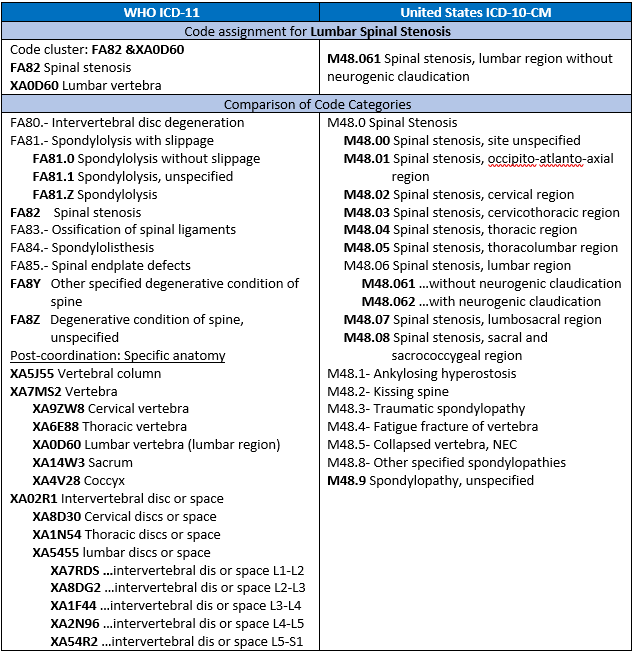The WHO ICD-11 classification is very different from the 10th version that the United States modified to create the ICD-10-CM code set that is used for reporting healthcare services on claims in the US today.
In monthly code comparisons, we’ve looked at codes that are pre-coordinated or post-coordinated in ICD-11 and compared them with the most closely associated pre-coordinated ICD-10-CM codes. This month we look at the extension code options to post-coordinate specific anatomy with a condition in ICD-11.
Let’s compare codes for a common condition, spinal stenosis, to illustrate ICD-11 extension codes for specific anatomy of the vertebral column.

Note:
- These code assignments reflect the closest equivalent code from each code set as of August 2023.
- Code category comparisons reflect excerpts from the ICD-11 MMS Browser compared to segments from the ICD-10-CM Tabular listing.
- Only the codes in bold are complete (valid) codes. Nonbolded codes require additional characters.
- The ICD-11 extension codes cannot be used alone, they must be post-coordinated with a stem code.
For this condition, the ICD-11 code is post-coordinated to create a “code cluster” that fully reflects the condition. Spinal stenosis is a “stem” code that is linked to the “extension” code reflecting the specific anatomy. The extension code for lumbar vertebra (XA0D60) is chosen rather than the extension code for lumbar discs or space (XA5455) because the anatomy is not specified as the intervertebral disc or space. A search for the specific anatomy “lumbar region” in the ICD-11 MMS browser shows that this is an inclusion term for lumbar vertebra (XA0D60). There are also extension codes, not included here, to represent manifestations of the spinal stenosis (such as myelopathy or radiculopathy, for example).
Notice all the ICD-11 extension codes start with an X, though the other characters could be either a letter or number. This is an intentional syntax used throughout ICD-11. In addition, the FA80- FA8Z stem codes have a consistent format, with additional detail added in numerical order and “other specified” or “unspecified” consistently represented with the “Y” or “Z” characters. In contrast, the characters of the ICD-11 extension codes, following the first X, do not hold any obvious inherent meaning.
Selection of the correct post-coordinated codes in ICD-11 and the correct pre-coordinated ICD-10-CM codes are both dependent upon the specificity of the clinical documentation. In both code sets, documentation of the region is key to correct code assignment.
If this makes you wonder how the codes for cervical or thoracic stenosis compare, visit the WHO website https://icd.who.int/en to browse ICD-11 codes or use the ICD-11 coding tool.
Mary H. Stanfill is Vice President of Consulting for United Audit Systems, Inc. and is the official representative of the IFHIMA to the WHO Family of International Classifications Education and Implementation (EIC) and Morbidity Reference Group (MbRG) workgroups. She has over 35 years of experience in the health information profession, primarily focused on clinical classification of healthcare data. She holds a masters in biomedical informatics and is currently pursuing a doctorate in health informatics.
Email: mstanfill@uasisolutions.com